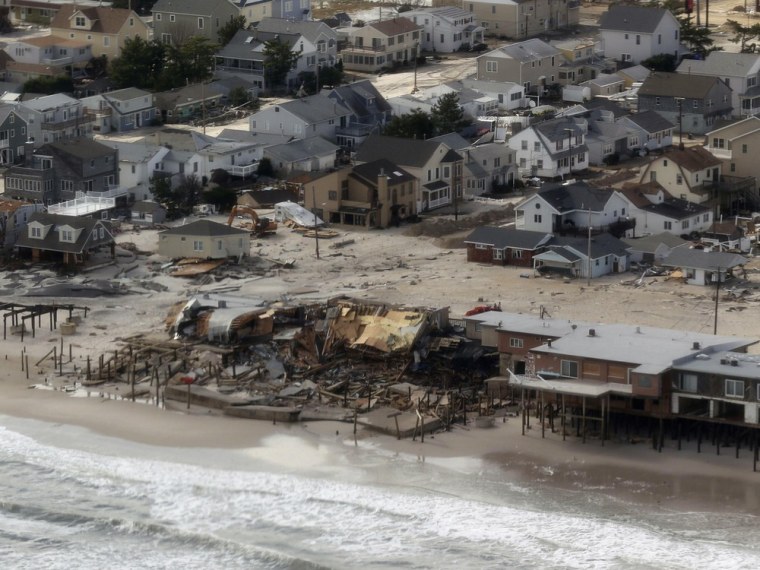Flood damage in the world's major coastal cities may top $1 trillion a year by 2050 due to rising seas and subsiding land, according to a new study.
The startling figure is "not a forecast or a prediction," but rather a means to "show that not to adapt and not to improve protection is impossible," Stéphane Hallegatte, a senior economist with the World Bank in Washington, D.C., and the study's lead author, told NBC News. "We have to do something."
The finding, which comes nearly 10 months after Superstorm Sandy's destruction, is shared by Hallegatte and colleagues in a report Sunday in the journal Nature Climate Change. Researchers considered current flood protections in 136 cities around the world, and found that in many instances they are inappropriate for sea levels that rise a projected 8 inches by the year 2050.
Many of the most vulnerable cities are in the U.S. Miami, New Orleans and New York, for example, account for 31 percent of the global aggregate losses in the 136 cities, making it stand out even from the world's other developed countries.
This may be because "the U. S. has trouble financing infrastructure, not only for coastal protection, but also transportation," Hallegatte said. That could be a reflection of how government functions in the U.S. with local, state, and federal agencies responsible for different aspects of infrastructure projects, he said. Whatever the reason, the finding illustrates that flood-reduction actions in a few places could be cost effective, he and colleagues said in the paper.
With global investment of about $50 billion a year in flood-protection measures such as higher sea walls and levees, much of these losses can be avoided, Hallegatte added. "It is a very good investment in financial terms," he said. "But if you look at who will pay and how we will pay for that, then it gets difficult."
Even with with flood protections in place, the annual costs in losses to flooding by 2050 will still be a significant $60 billion to $63 billion, the report said.
Inappropriate flood protections are actually worse than no protection at all, Hallegatte said. That's because a too-short sea wall, for example, provides a false sense of security, emboldening people who live behind it to build more densely than they otherwise would. When the flood hits, there is more to lose.
"These are scary numbers and they are likely to be underestimates," Mike Beck, a marine scientist with The Nature Conservancy who studies coastal impacts from flooding, told NBC News. He was not involved with the new study.
That's because, he said, the researchers use "conservative" estimates of development on the coastlines as well as they only consider the growing flood risk from rising seas. There is evidence, he noted, that increased storminess will lead to more floods. And, the loss of ecosystems is not accounted for in the study.
Coastal wetlands, sand dunes, mangrove forest, coral reefs and other natural habitats "play a role in providing protection from sea level rise and storms," Katie Arkema, a marine ecologist at the Stanford Woods Institute for the Environment, told NBC News. She the lead author of a recent study, also in Nature Climate Change, about the role of coastal habitats in protecting people and property.
She was surprised that the value of ecosystem components — such as sand dunes and coral reefs — were barely mentioned in the new analysis, but called the new work "an important paper. It identifies which coastal communities are most vulnerable … and that some adaptation measures are needed to reduce probability of flooding."
Hallegatte said the paper does primarily consider infrastructure investments in "concrete" protections, but noted that "there are limits to what you can achieve with dikes and barriers."
Adaptation strategies going forward, he said, need to integrate both concrete and ecosystem protections. For example, a wetland or mangrove forest can take some energy out of an approaching storm surge before it runs into a sea wall.
Even with all of these protections in place, he added, "the worst is possible. Protection can fail. And there have to be plans for that — crisis management, reconstruction management, and also international collaboration for when a country is affected very heavily, especially poor countries."
John Roach is a contributing writer for NBC News. To learn more about him, visit his website.
